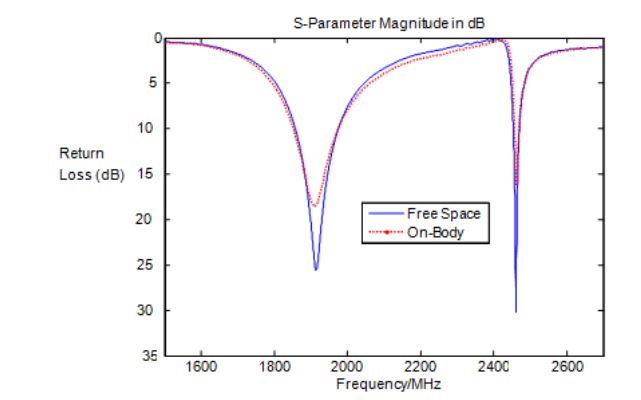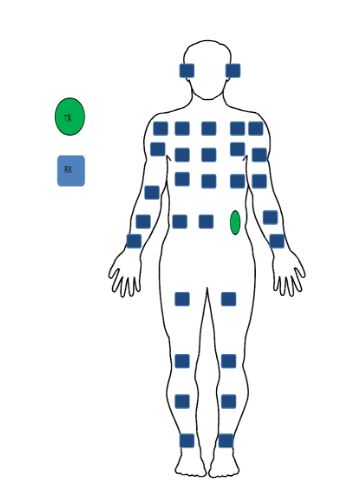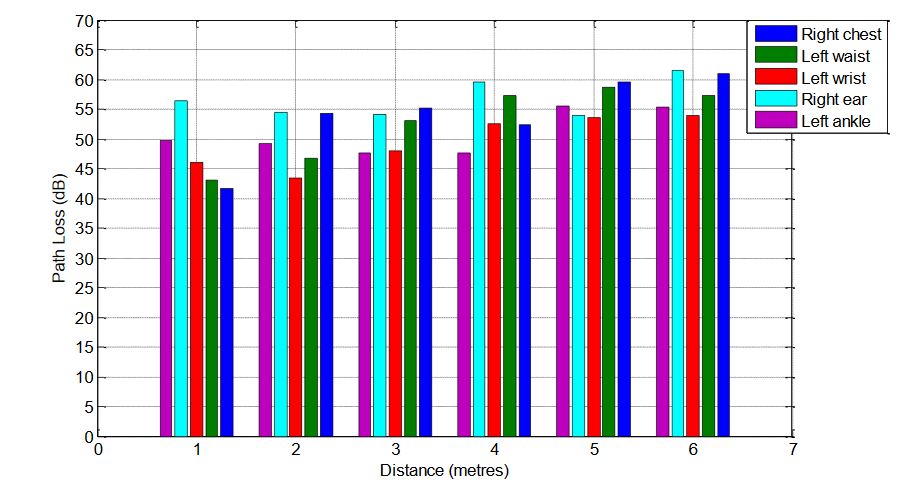ABSTRACT
In this paper, a dual band planar inverted F antenna (PIFA) has been investigated for cooperative on- and off-body communications. Free space and on-body performance parameters like return loss, bandwidth, radiation pattern and efficiency of this antenna are shown and investigated. The on- and off-body radio propagation channel performance at 2.45 GHz and 1.9 GHz have been investigated, respectively.
Experimental investigations are performed both in the anechoic chamber and in an indoor environment. The path loss exponent has been extracted for both on- and off-body radio propagation scenarios. For on-body propagation, the path loss exponent is 2.48 and 2.22 in the anechoic chamber and indoor environment, respectively.
The path loss exponent is 1.27 for off-body radio propagation situation. For on-body case, the path loss has been characterized for ten different locations on the body at 2.45 GHz, whereas for off-body case radio channel studies are performed for five different locations at 1.9 GHz. The proposed antenna shows a good on- and off-body radio channel performance.
ON-BODY PERFORMANCE PARAMETERS OF DUAL BAND PIFA

Figure 1. (a) Software design; (b) Fabricated version; (c) Schematic diagram of the dual band planar inverted F antenna PIFA
The schematic diagram and fabricated dual band Planar Inverted F Antenna (PIFA) are shown in Figure 1. The antenna was modeled on FR4 substrate with a thickness of 1.57 mm and a relative permittivity of 4.6. At the backside of this antenna there is a full ground plane. The total height of the antenna is 6.92 mm and the overall ground plane size is 63 × 34 mm2. The dimension of PIFA elements are given in Table 1 and shown in Figure 1c.

Figure 3. Simulated free space and on-body (1 mm away from human body) return loss responses of the dual band PIFA
Figure 4 shows measured return loss curves of the dual band PIFA when it is placed on the right side of the chest varying the distance between the antenna and the body. Results illustrate that when the antenna is placed on the human body, a maximum up to 40 MHz (2.13 %) frequency detuning from the free resonance frequency is noticed at the lower frequency band while at higher band there is no frequency detuning. At lower frequency band, the frequency detuning decreases as the distance between the body and the antenna increases.
INVESTIGATION OF ON-BODY RADIO PROPAGATION CHANNELS AT 2.45 GHZ

Figure 8. The transmitter antenna is on left waist and the receiver antenna is attached to 31 different locations on the body for on-body radio propagation measurement at 2.45 GHz
A HP8720ES vector network analyzer (VNA) was used to measure the transmission response (S21) between two PIFAs placed on the body. The transmitter antenna connecting with the cable was placed on the left waist, while the receiver antenna connecting with the cable was successively placed on 31 different locations on the front part of the standing human body; as shown in Figure 8. The test subject was standing still during the measurements and, for each receiver location and measurement scenario, 10 sweeps were considered.

Figure 12. Comparison of path loss for left waist to 10 different on-body links at 2.45 GHz, measured in the chamber and in an indoor environment, of the dual band PIFA
Figure 12 shows the comparison of path loss for left waist to ten different on-body links at 2.45 GHz measured in the chamber and in an indoor environment using dual band PIFA. It is noticed that both in the chamber and in indoor environment cases, the lowest path loss value is observed for the left waist to left chest and left wrist links while the highest is noticed for the right ear and right wrist channels.
INVESTIGATION OF OFF-BODY RADIO PROPAGATION CHANNELS AT 1.9 GHZ

Figure 14. Measured and modeled path loss for off-body channel vs. logarithmic transmitter (Tx) and receiver (Rx) separation distance 1.9 GHz for the dual band PIFA
A least square fit technique is performed on measured path loss for all five off-body channels (1~6 m) at 30 different transmitter locations to extract the path loss exponent (see Table 4). Figure 14 shows the measured value and modeled path loss for off-body channel vs. logarithmic transmitter (Tx)-Receiver (Rx) separation distance showing path loss exponent for the dual band PI FA at 1.9 GHz.

Figure 16. Comparison of path loss for five different off-body channels at 1.9 GHz measured using dual band PIFA, when subject was standing still at 1–6 m locations in sensor laboratory
In this section, off-body radio propagation channel at 1.9 GHz of the dual band PIFA has been characterized. Five different off-body radio channels (right chest, left waist, left wrist, right ear and left ankle) were considered (Figure 13a). The measured path loss data for these five off-body radio channels were extracted from the previous measurement results of 1.9 GHz off-body measurement case. Figure 16 shows the comparison of path loss for five different off-body radio channels, when subject was standing still at one to six meter locations measured in the indoor environment.
CONCLUSIONS
A dual band planar inverted F antenna (PIFA) is designed for cooperative on-body and off-body communications to be applied in healthcare applications. The performance parameters in close proximity of the proposed dual band PIFA have been investigated. Results and analysis show that the performance parameters of the proposed dual band PIFA are not affected much by the human body effects.
The antenna shows very good on-body performance when placed very close to the human body. The on-body radio channel behavior at 2.45 GHz of this PIFA has been experimentally investigated in the anechoic chamber and in an indoor environment. In addition, the off-body radio channel behavior of this dual band PIFA at 1.9 GHz has been investigated in an indoor environment.
The path loss exponent for on-body propagation at 2.45 GHz and off-body propagation at 1.9 GHz has been extracted and analyzed. In addition, the on and off-body radio channel characterization has been investigated and analyzed. The antenna has compact size and it shows very good on-body and off-body radio channel performance. Based on the results and analysis, this compact dual band PIFA will be very good candidate for on and off-body communications in healthcare applications.
Source: Queen Mary University
Authors: Mohammad Monirujjaman Khan | Qammer H. Abbasi | Ratil Hasnat Ashique
>> 60+ Antenna Communication Projects for Engineering Students
>> Project Report on Microstrip Patch Antenna for Engineering Students